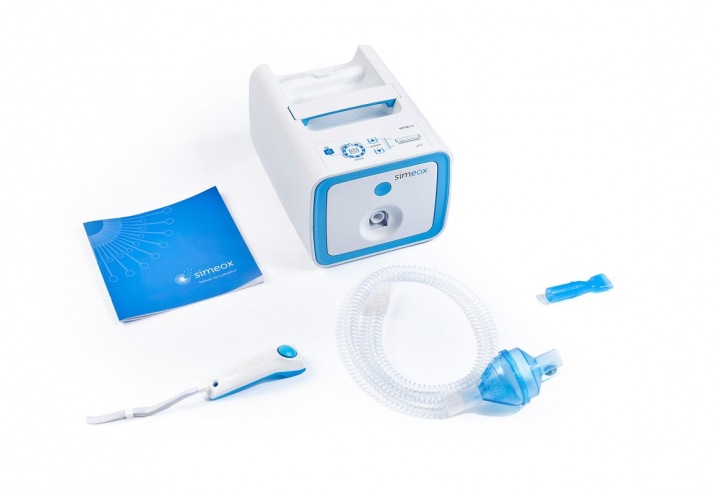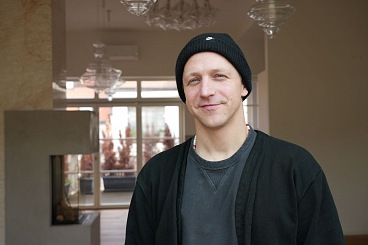PCD: Many doctors do not know this congenital lung disease. It is very underdiagnosed and incurable, says Doctor Koucký
Dr. Václav Koucký works at the Pediatric Clinic of the Second Medical Faculty of Charles University and at the Faculty Hospital in Motol. He specializes in rare, often incurable lung diseases that are hard to identify. Among them is Primary Ciliary Dyskinesia. In the interview, he explains how the disease manifests, what treatment options exist, where missteps can occur when diagnosing and the reasons why health insurance companies do not reimburse all necessary treatments.
Doctor, could you explain the disease primary ciliary dyskinesia (PCD)?
Primary ciliary dyskinesia is a congenital disease, which we also refer to as the syndrome of immobile cilia. We can imagine cilia as such brushes on the surface of cells in the respiratory tract, whose task is to "sweep" those respiratory tracts. That means to clear mucus, which naturally forms there. They oscillate in a regular mode in one direction and thus clear the respiratory tract. If we have these cilia immobile or poorly mobile, then this "cleaning" does not occur, mucus accumulates in the respiratory tract and various impurities including bacteria can accumulate in it. Therefore, frequent infections and long-term inflammation occur there, which can then cause damage to the respiratory tract.
You mentioned that this is a congenital disease. When is this disease actually discovered?
It is present at birth. However, the symptoms can gradually develop, so they may not be present immediately at birth. Of course, it also depends on how severe the form of the disease is, how intensely the parents perceive the symptoms and problems of the patient and of course, when the patient gets to a doctor, who also has to think about it and perform a proper examination. I would add that primary ciliary dyskinesia is a highly underdiagnosed disease. Partly for the reason that awareness about it is still not too great, many doctors do not know the disease or do not think about it initially, when they receive a patient with symptoms that could fall under primary ciliary dyskinesia. The second thing is that the diagnostic process of this disease is also quite demanding. We don't have one test, which we could perform and could say a hundred percent whether the patient has the disease or not. It is a whole cascade of various demanding examinations, from common to highly specialized ones, like electron microscopy examination or genetic examination, which ultimately leads to a clear diagnosis.
Unfortunately, this disease is so heterogeneous, meaning diverse, that the patients differ from one another to such an extent that in many cases we might have a high suspicion that it's PCD, but we cannot say it with hundred percent accuracy because we do not have the genetic cause or the electron microscopic finding, so we say that we are convinced that it's PCD, but we cannot diagnose it with hundred percent certainty. So, the diagnosis is very complex.
What are the initial symptoms of this disease?
The symptoms are very diverse. It should be noted that not only the respiratory system is affected, but other organs can be affected as well. When we talk about the respiratory tract, perhaps the most significant symptom is congestion, long-term, practically permanent. In the upper respiratory tract i.e. runny nose, or chronic inflammation of the sinuses, if the child has developed sinuses. There can be frequent middle ear inflammations, often with the need to puncture the eardrums, or there may be hearing impairment, which is caused by the fact that the middle ear is filled with this viscous mucus (secretion), which clogs it, and therefore the ear bones do not function sufficiently and children may have hearing impairments. This applies to the upper respiratory tract and these symptoms can appear already in the newborn age. Often mothers say "he was already congested in the maternity hospital, when his nose was running" which is certainly not a typical symptom for newborns. Furthermore, these newborns may have problems with breathing shortly after birth. At first glance, a healthy baby, but after the first 4 to 12 hours it suddenly begins to breathe badly, ends up on oxygen, it needs to be in the incubator for some time, then the condition improves, it is sent home, but then more frequent infections of both upper and lower respiratory tracts and difficulties with breathing start to accumulate there.
So these symptoms may be present in newborns or develop later during childhood.
As for the lower respiratory tract, children often have bronchitis, possibly even pneumonia. There may also be a collapse of the lung, which means airlessness, when it gets blocked by mucus and the lung cannot function. Sometimes they end up on oxygen. Other times, they have episodic states of coughing, shortness of breath, decreased tolerance of physical stress. It depends very much on the severity of the disease, how severe the injury is and how effectively it is treated. All of this applies to the respiratory tract, but it is necessary to realize that these symptoms can also be outside of the respiratory tract. For example, it can be a so-called disorder of body laterality, which means that you have reversed organs in the body, different than we are used to. Instead of having the liver on the right, we have it on the left - the entire body is mirror-reversed. That's a typical symptom. We could say that about 50% of patients with PCD have this reversed position of the organs in the body, but not everyone with a disorder of this laterality has to have PCD. So it's one of the symptoms, but it's not a confirming symptom. Also, these children more often have congenital heart defects, so various developmental defects. There may be problems with fertility, which concerns adult patients. Men may have decreased fertility, women have a higher risk of ectopic pregnancy.
Is it likely that the patient's parents suffer or suffered from this disease?
Not exactly. The genetics are very diverse, but most often we encounter autosomal recessive forms, which means that for the child to become ill, a father and a mother who are carriers of the mutation must come together. This means that neither the father nor the mother will have symptoms, but when two "right" people meet, they have a 25% chance that they will give birth to a child who will eventually have the disease. Typically, we encounter that the parents are without symptoms, but are carriers, so-called healthy carriers, and the child then has one of several diseases.
What is the treatment for this disease?
The treatment of this disease is symptomatic. This means that we try to solve the problems that the child has. Unfortunately, we do not have any causal treatment, i.e. a treatment that would cure the triggering cause and would be able to completely cure this disease.
We need to say that we are not able to completely cure PCD, but we are able to treat it - alleviate the symptoms, improve the quality of life so that, for example, these children will not experience any significant restrictions in their daily activities.
Of course, they have to take more care of themselves, tend to their respiratory system. We compare it for them to when their cilia, which cleans the respiratory tracts, do not function, they have to clean it themselves. It involves regular inhalation, doing breathing exercises, protecting themselves from various infections. In doing so, they take over the function of the cilia, which in healthy people normally function automatically, but for them it is not automatic and they have to take care of them. If they do it effectively and correctly, the quality of life can be very good, when they have no major limitations - they can play sports, go to school normally, go on vacation, etc.
I read that one of the possible treatments is antibiotic treatment.
Yes, antibiotics play an important role because in those airways where mucus accumulates, bacteria also likes to accumulate. It's like a nutrient-rich environment for them, they live there better than in clean airways. In addition, even the immune system, which in children with PCD has no dysfunction, functions normally, but has more problems removing bacteria from that thick and accumulated mucus. So antibiotics are definitely a crucial part of this treatment. In most cases, we administer them as needed, meaning when symptoms and signs of infection worsen. For the most severe forms, antibiotics can also be administered preventively, they take them three times a week, one tablet, trying to prevent a deterioration.
This must be a huge strain on the body in the long run.
Of course, it is generally not good to take antibiotics unnecessarily. However, in this case, we need to understand that we are balancing two negative things. If we want to have chronic inflammation of the respiratory tract with a long-term infection that will destroy the lungs in the long term, and of course in the short term causes this child to deteriorate, where I see a temperature increase, it starts to breathe harder, these are so-called exacerbations. So on one side of the scale is our attempt to prevent this and we know that each of these exacerbations (worsenings) chips off a piece of those lung functions that we are given at the beginning. This can cause a scar on the lungs or some structural damage, so we know that the fewer of these exacerbations, the better for the patient. On the other side of the scale, of course, is that we give antibiotics regularly and long-term. We are putting pressure on the bacteria in the sense that they can get used to it and become resistant (resistant) to the administered antibiotic and then we have to change the antibiotic. Of course this is not good for that patient, it affects his intestinal microflora and overall, and of course, this is not good for our population as a whole because this is how we create those bacteria that are resistant and will not respond well to the antibiotics. Therefore, we must look for a very good balance between whether the benefits of long-term antibiotic treatment outweigh the risks. That's why I said it's reserved for patients with the most severe course, and of course, we try to supplement it with treatment to clean the respiratory tract.
How many patients are currently suffering from this disease in the Czech Republic?
I can't give you an exact number, but it's around 150 to 170 individuals. We have done research on the incidence, we have some data and the incidence is said to be around 1 in 10 to 40 thousand inhabitants.
One of them is eighteen-year-old Daniela. What stage is she at?
We treat children up to practically 19 years of age, so Daniela is in that transitional period when we are looking for an adult pulmonologist who will take care of her in the future, because this is an incurable disease and needs regular long-term care.
Daniela has been treated with us since childhood, for over ten years.
She was diagnosed around the age of 10 to 11 when some irreversible lung damage had already occurred. However, she is very careful, she tries, so that treatment managed to slow down the course of the disease and minimize the damage. But we have significant lung damage with Daniela, but we managed to positively influence it to a certain extent through the treatment, but not to cure it.
She was diagnosed at the age of 11. What happened up until then?
Until she was eleven, she was often sick, underwent various examinations and was treated like regular children who suffer from frequent pneumonia or bronchitis. She was given antibiotics as needed and there was no targeted therapy such as respiratory rehabilitation and inhalation.
So some treatment was ongoing, but it was not as effective, which is not favorable.
Generally, we try to diagnose those who are sick as early as possible, because we know that the earlier we diagnose, the earlier we treat and prevent further damage to the respiratory tract. Eleven years is unfortunately roughly the average age at which children with PCD are diagnosed in the Czech Republic. Fortunately, we have recently been able to increase awareness of this disease and to make diagnostic procedures more efficient. We now diagnose it at an earlier age in children, around 6 to 7 years. There, the prognosis is then better than for Daniela. We try to provide her with the maximum possible care, to stabilize her disease and ensure her a good quality of life.
Could it be said that there is some kind of medical malpractice if PCD is not detected in time?
The question is how we understand the term malpractice. Of course, the sooner we diagnose it, the better it will be for the patient. But as I have already mentioned, the symptoms are often nonspecific and the examinations may not definitively determine the cause. We can have some test results as normal, and yet the PCD may still be there, so I would not categorically label it as malpractice. But of course, if the patient comes across an enlightened doctor who manages to diagnose it in time, it will certainly improve his prognosis.
Despite initial complications, this happened to Daniela. Her story was recorded by the Naše plíce foundation, which launched a collection for a Simeox device for her. How will it help her?
The Simeox is supposed to help her clean her airways properly. It is a kind of device that combines overpressure and underpressure in the airways, so it acts like a vacuum cleaner, sucking air from the airways and thus helping to evacuate the mucus that accumulates there. It also has the ability to vibrate, which shakes the air column in the airways, causing the mucus to detach from the wall and be coughed up more easily. Some studies even show that these vibrations can change the mechanical properties of the mucus, making it thinner and less sticky. It is a very effective method to improve the cleaning of the airways. It is not a standalone treatment, it is always combined with some inhalations and other respiratory techniques, where it increases their efficiency.
There are many aids for treatment that are paid for by insurance, but what about this device?
The more expensive each aid is, the more restrictive the insurance company is and there are criteria that must be met for them to pay for it. In some cases, it may be reserved for the most severe forms of the disease. However, we know that the earlier we start treating, the more effective it is. On the one hand, we are therefore forced to wait within some economic setting of our health system until the criteria are met and the aid is approved, even though we know that if we had given it a few years earlier, it could have positively influenced the prognosis. Thus, even the aids that are paid for may have some limitations from a certain stage of the disease. In individual cases, of course, it is possible to talk about trying to give the aid earlier.
In the case of Simeox, the situation is even more complicated in that he does not have a reimbursement code, i.e., the insurance company does not reimburse it through the standard method.
Luckily, our healthcare system is good in the sense that it leaves us open such backdoors for the most special cases, when it is possible to apply for an exception upon specifying the situation, and the insurance company will individually assess it and decide whether or not to reimburse it to that specific patient. Success is not guaranteed, but it is an option with the caveat that it may not be approved in time, but only in later stages. The insurance company can say yes, but he does not have such severe impairment yet for us to pay for it. Hence, it could happen that if we applied on behalf of Daniela, they would say no.
So you didn't ask Daniela?
We tried, but we were not successful.
What are the forecasts for Daniela in the future, if she was not under control?
If the disease was not under control and was not treated adequately, the structural lung damage would of course deteriorate and the lungs could be completely destroyed and it could end up with their transplantation.
Is this a threat to Daniela?
I firmly believe that she will continue to take good care of her lungs and that we will be able to postpone it as much as possible and that she won't reach this stage. However, we can't promise that.
Thank you for the interview and have a nice day.
Source: author's text, own questioning
















